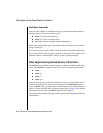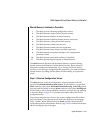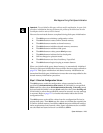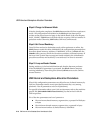
System Architecture 2-11
What Happens During Shared-Memory Initialization
Shared-Memory Initialization Procedure
1. The tbinit process calculates configuration values.
2. The tbinit daemon creates OnLine shared memory.
3. The tbinit daemon attaches to shared memory.
4. The tbinit daemon initializes shared-memory structures.
5. The tbinit daemon wakes parent tbinit process.
6. The tbinit daemon initiates fast recovery.
7. The tbinit daemon initiates the first checkpoint.
8. The tbinit daemon drops temporary tables (optional).
9. The tbinit daemon documents changes in the configuration
parameter values.
10. The tbinit daemon sets forced residency, if specified.
11. The tbinit daemon begins looping as master daemon.
The tbinit daemon allocates OnLine shared-memory segments during
shared-memory initialization. OnLine shared-memory space cannot be
allocated or deallocated dynamically. If you change the size of shared
memory by modifying a configuration file parameter, you must reinitialize
shared memory by taking OnLine offline and then taking it to quiescent
mode.
Step 1: Calculate Configuration Values
The tbinit process reads the configuration values contained in the file
specified by $INFORMIXDIR/etc/$TBCONFIG. If TBCONFIG is not specified,
tbinit reads the values from $INFORMIXDIR/etc/tbconfig.Iftbconfig cannot
be found and TBCONFIG is not set, tbinit reads the values from tbconfig.std.
If TBCONFIG is set but the specified file cannot be accessed, an error message
is returned. Refer to page 1-11 for further information about the OnLine
configuration files.
The process compares the values in the current configuration file with the
previous values, if any, that are stored in the root dbspace reserved page,
PAGE_CONFIG. Where differences exist, tbinit uses the values from the
configuration file for initialization. Refer to page 2-95 for further information
about root dbspace reserved pages.


















